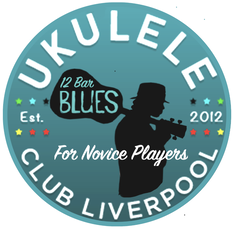WELCOME TO UCL ONLINE

Thanks for choosing the Ukulele Blues for Beginners Course. Enjoy!
This course contains a range of media content to help you learn the content including bite sized video tutorials, illustrations, tab exercises, PDF downloads, audio play along tracks with audio descriptions of all content at the bottom of each page.
Media and training materials contained within this online course are produced by Ukulele Club Liverpool for UCL Online services only and should not be shared, copied or redistributed without consent. Before you begin please watch the video below, get yourself orientated and make sure you check out the music theory terms below before you enter the course.
This course contains a range of media content to help you learn the content including bite sized video tutorials, illustrations, tab exercises, PDF downloads, audio play along tracks with audio descriptions of all content at the bottom of each page.
Media and training materials contained within this online course are produced by Ukulele Club Liverpool for UCL Online services only and should not be shared, copied or redistributed without consent. Before you begin please watch the video below, get yourself orientated and make sure you check out the music theory terms below before you enter the course.
HOW IT WORKS:
This online course contains 10 modules designed to guide you step by step through the process of playing the 12 bar blues for both rhythm (chords) and lead (licks & solos) sections. By the end of the course you will have developed skills that you can transfer into other songs and music genres.
You will have access for 12 months from the date of purchase, so plenty of time to get to grips with all of the content. Go at your own pace and try not to skip any parts as they all lead to making you a better ukulele player and musician. Once you have mastered the techniques, invite some muso friends round for a jam.
If you run into any technical issues along the way please contact us immediately at [email protected] so that we can sort them out.
You will have access for 12 months from the date of purchase, so plenty of time to get to grips with all of the content. Go at your own pace and try not to skip any parts as they all lead to making you a better ukulele player and musician. Once you have mastered the techniques, invite some muso friends round for a jam.
If you run into any technical issues along the way please contact us immediately at [email protected] so that we can sort them out.
COURSE OUTLINE:
You can click on the module titles below to access selected modules. At the bottom of each page you will have the option to proceed to the next module or go back to the previous module.
INTRODUCTION:
Your host begins by playing through the full track of 12 Bar Blues from basic beginner level to intermediate level along with introducing the essential training elements of the course.
MODULE 1: BLUES ORIGINS
Find out where the Blues originated and why, who brought the Blues to the limelight and the different styles of blues music. Click on the highlighted links to listen to some blues music before you get started and watch the Blues Documentary to gain a better understanding of the Blues Origins and influences.
MODULE 2: BLUES CHORDS
You will be pleased to know that most blues music is based around just 3 chords known as the 1, 4, 5 progression. In This module you will discover three major chords, but there will be more chords along the way.
MODULE 3: 12 BAR BLUES
This module will get you measured up to find out where those chords fit into the 12 bars.
MODULE 4: SHUFFLE RHYTHM
Learn how to really get that blues groove going with the Shuffle rhythm.
MODULE 5: RELATIVE MINORS
This is where the fun really starts to unfold, finding those relative minors will not only give you a better understanding of a bit of theory behind the music, but also bring your blues sound to life.
MODULE 6: TURN AROUNDS
The 12 Bar Blues can go on for ever. At the end of each 12 bar section, you will discover how to switch up those last two bars to take you into the next section with walk downs, additional blues notes and 7th chords.
MODULE 7: THE BLUES SCALE
This is a great scale to know and will have you jamming for hours on end with just 6 notes, you will be able to create some interesting solos phrases.
MODULE 8: SOLO TECHNIQUES
These techniques will help you take those solos to the next level and have you sounding like a pro. It is important to practice them all independently before adding them into the mix and are highly transferrable.
MODULE 9: LICKS & TRICKS
Just when you thought those solo techniques would make you sound great, adding in some of these blues licks will make you sound awesome.
MODULE 10: BLUES JAM
This module will help you get your jam on with downloadable MP3 files to help you practice your 12 bar blues chords and solos. Please complete the survey at the end to help us continue to improve our online services.
Your host begins by playing through the full track of 12 Bar Blues from basic beginner level to intermediate level along with introducing the essential training elements of the course.
MODULE 1: BLUES ORIGINS
Find out where the Blues originated and why, who brought the Blues to the limelight and the different styles of blues music. Click on the highlighted links to listen to some blues music before you get started and watch the Blues Documentary to gain a better understanding of the Blues Origins and influences.
MODULE 2: BLUES CHORDS
You will be pleased to know that most blues music is based around just 3 chords known as the 1, 4, 5 progression. In This module you will discover three major chords, but there will be more chords along the way.
MODULE 3: 12 BAR BLUES
This module will get you measured up to find out where those chords fit into the 12 bars.
MODULE 4: SHUFFLE RHYTHM
Learn how to really get that blues groove going with the Shuffle rhythm.
MODULE 5: RELATIVE MINORS
This is where the fun really starts to unfold, finding those relative minors will not only give you a better understanding of a bit of theory behind the music, but also bring your blues sound to life.
MODULE 6: TURN AROUNDS
The 12 Bar Blues can go on for ever. At the end of each 12 bar section, you will discover how to switch up those last two bars to take you into the next section with walk downs, additional blues notes and 7th chords.
MODULE 7: THE BLUES SCALE
This is a great scale to know and will have you jamming for hours on end with just 6 notes, you will be able to create some interesting solos phrases.
MODULE 8: SOLO TECHNIQUES
These techniques will help you take those solos to the next level and have you sounding like a pro. It is important to practice them all independently before adding them into the mix and are highly transferrable.
MODULE 9: LICKS & TRICKS
Just when you thought those solo techniques would make you sound great, adding in some of these blues licks will make you sound awesome.
MODULE 10: BLUES JAM
This module will help you get your jam on with downloadable MP3 files to help you practice your 12 bar blues chords and solos. Please complete the survey at the end to help us continue to improve our online services.
HANDY MUSIC ELEMENTS:
There are a few key music theory elements that you should familiarise yourself with before you begin. Click on the blue titles of each section for a detailed explanation on each music element via Wikipedia:

TIME SIGNATURE:
The song in this course is in 4/4 time, also known as Common Time and can be represented with either a 4/4 or a 'C' symbol.
The song in this course is in 4/4 time, also known as Common Time and can be represented with either a 4/4 or a 'C' symbol.

BAR: A bar, also known as a measure, works in association with the time signature. At 4/4 time, there is the equivalent to 4 quarter notes per bar. They are literally the boxed sections. Bar lines separate each bar.

TEMPO: The tempo represents the speed songs are to be played at. Throughout this course, all training materials will have embedded click tracks to help you solidify and master your speed and timing.

RHYTHM: Strumming patterns with arrows marking 'down' and 'up' strums are used to acknowledge rhythm patterns within this course. Down beats generally fall on the beat and up beats in between. The '+' symbol represents the mid beat section.

TAB: Tab is used for various exercises throughout this course. Don't worry if you are not familiar with tab as all exercises will be explained within the video tutorials. The lines of tab represent the strings of the ukulele, and the numbers represent the frets that you should play.
